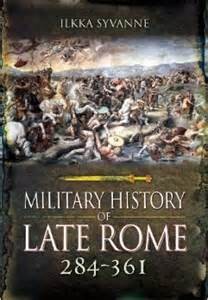|
Reviewed by Dr. Wyndham Whynot, Professor of History, Livingstone College When one thinks of Rome’s military history and forces, individuals often think of the pre-Augustinian era: Julius Caesar’s Gallic Wars, the Punic Wars, while others might have familiarity with Rome’s military forces and operations up through 100 A.D. Syvanne’s book presents an ambitious attempt to discuss Rome’s military history from 284 up through the end of the Roman Empire. Volume one focuses on the era from the beginning of Diocletian’s reign in 284 through Constantius’ II death in 361. Using a holistic approach that examines Roman military and allied forces, as well as those of the potential enemies, the author provides an overview of their society’s political and military institution, various branches of military forces, social classes, finances, personnel, finances, tactics, and strategies. Starting with the British Isles and generally working geographically clockwise around the Mediterranean Sea to Northwest Africa, Syvanne discusses the various ethnics groups that challenged or assisted the Roman military forces found in each region. Many groups receive a brief overview; however, more important threats or allies such as Goths, Sasanians, Armenians, etc. receive more attention. After providing an overview of the empire’s decline starting with the Emperor’s Caracalla military reforms that appeared to reduce Rome’s military strength in the long-term and his murder in 217, the author examines a variety of conflicts, usurpations and civil war threatening Rome’s stability, as well as Emperor Gallienus’ military reforms during the mid-third century. As Rome heads toward the latter part of this century, Syvanne focuses his attention on the reign of Emperor Probus, whom he praises for his military ability, yet was killed during a coup instigated by one of his officers, which led to events resulting in the rise of Diocletian and the establishment of the tetrarchy. Approximately the last sixty percent of the book provides an in-depth look at the reigns of Diocletian and his co-rulers, Constantine’s rise to supremacy as ruler of the empire, and the era of his sons until the death of Constantius II in 361. Syvanne covers such matters as Diocletian’s establishment of shared rule in attempt to provide for smoother government succession, yet shows how this actually created constant conflicts between co-rulers. In some way, we see that although policies and reforms created changes, must of the conflict and need for military actions continue the same as prior to Diocletian’s reign. Constantine, considered by the author as the greatest Roman military leader of the fourth century, receives significant attention regarding military reforms, his use of combined arms, and support of Christianity to increase his popularity and arguably some of his success in seizing control from his rivals during his lifetime. Ending with an examination of Constantine’s sons’ co-reigns of the empire, Syvanne shows that the sons learned the lessons of their father, as each used their Roman legions and military forces to overthrow each other until only Constantius II remained as the ruling emperor. Syvanne makes an unusual decision regarding his usage of his research materials, one that makes the work of less use to some scholars, especially those lacking solid knowledge of Roman military history. Despite an impressive number of sources from Roman authors of the era and the extensive use of secondary works, the author limits many of his citations to “only in such cases that need to be argued further”(p. x), which could prevent readers from finding the specific information Multiple maps generally complement the text, yet some are so crowded with information that they are difficult to read. Photos of Roman equipment and Roman military re-enactors; coinage and statuary showing various Caesars; as well as illustrations of various military equipment, tactical formations, fortifications, soldiers (Romans, Allies, and Enemies); and various battles are also used to demonstrate elements the author discusses. An appendix provides a two page overview of the Christian controversies confronting Rome during Constantine’s reign. To some degree this work is somewhat similar to Osprey’s Rome and her Enemies: An Empire Created and Destroyed by War, which is probably a superior work in regards to its coverage of Rome from 735 BC to 500 AD, illustrations and mapping of battles, but Syvanne’s work is more comprehensive in its coverage of the years 284-361. Scholars and individuals interested in Rome’s military institutions in the mid-imperial age will find this work useful. This reviewer believes the work provides a comprehensive examination of Rome’s military history during this period of the empire and looks forward to the forthcoming volumes. |


 Military History of Late Rome: 284-361
Military History of Late Rome: 284-361